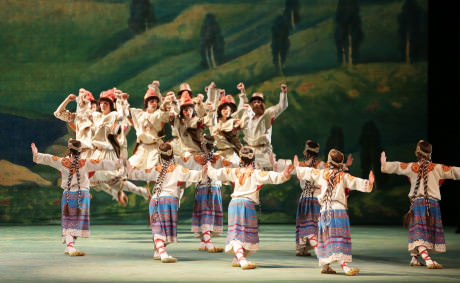Russians return to the glory days of ballet
Ulyana Lopatkina could have wrapped up The Kennedy Center and taken it home with her after her performance in The Swan, a.k.a. The Dying Swan, created by Michel Fokine in 1905 to Camille Saint-Saens’ cello solo Le Cygne. The gorgeous redheaded prima ballerina – I dare anyone not to call her a goddess – returned to the Mariinsky’s past for Grand Pas, a restaging of Marius Petipa’s 1881 Paquita that closes the program of late 19th and early 20th century choreography.

Lopatkina is simply adored by her fans – both Russians and Americans, judging from the accolades in two languages. St. Petersburg’s Mariinsky Ballet boasts the best ballerinas and male bravura – the kind of dancing we’ve come to expect from the company that gave us Mikhail Baryshnikov, Rudolf Nureyev, and Natalia Makarova. The three-part program closed with Paquita, surely the finale last evening’s sold-out audience came to see – a remarkable Russian legacy of theatrical and musical traditions under the banner of classical ballet.
Although it has been viewed by millions on TV, in films, and countless times onstage, especially gala celebrations, the dying swan still haunts us with her ethereal bourees (gliding movements), as if she could fly away from danger in an instant. Instead she falters towards the edge of the stage, quivers, sinks to one knee, fighting against gravity to her death. Perhaps Lopatkina, still youthful at 42, was bidding adieu to us last night in her swan solo. She is not scheduled to dance in the remaining six performances at the Kennedy Center.
Still we can always hope for a change in the programming. The Russians love drama!
What is it about Russian dance that makes it so difficult to describe its virtues and so easy to forgive its sins? The answer may be not so much in the dancers’ obvious talent, but in the total commitment apparent in every step and gesture.

Michel Fokine’s 1911 little gem, Le Spectre de la Rose, captures the essence of Russian romantic ballet. Based on a poem by the ultimate romantic, Theophile Gautier, and set to the lyrical strains of Carl Maria von Weber, Spectre can be a tough call in today’s world with little nostalgia for those otherworldly tales by our grandparents. It’s a charming ballet about first love, a magic moment, much like your first kiss (or whatever sweet memory you want to insert).
Kristina Shapran was especially dreamy as the Young Girl, and Vladimir Shklyarov was razor-sharp in the title role made famous by Vaslav Nijinsky. The costumes were designed after the originals by Leon Bakst – love the Valentine red jumpsuit. Set designer Viacheslav Okunev cleverly created two windows to jump through, coming and going. You got to see these grand leaps to appreciate the talent.
For this writer (and surely the serious ballet historians in the audience – those able to pronounce all nine syllables of the dancers’ names), Le Sacre du printemps, Scenes from pagan Russia in two parts reigned supreme in the opening program. It is worth the price of a ticket (and some are steep and hard to find) to see this brilliant piece of ballet history. Spoiler alert: Last night’s audience was lukewarm in its appreciation. That’s a lot better than the reported violence that erupted when it premiered in Paris 101 years ago.

Nijinsky’s created his Sacre that may changed the course of modern dance, had it not been banished so quickly. A heavy, pigeon-toed, Slavic pagan ritual – complete with sacrificial maidens and men wearing bear skins over their shoulders – was hardly what the Paris balletomanes had grown to love at the ballet. They were accustomed to the lilting waltzes of Sleeping Beauty, etc. No wonder there was a riot, especially with the thunderous score of Igor Stravinsky supposedly overpowering the dancers.
It was my privilege to attend a 1987 critics’ conference in Manhattan on the reconstruction of Sacre with dance historian Millicent Hodson who solved the mystery of recreating this famous work from few musical notes, a few photographs, and live interviews with two surviving dancers. What Hodson uncovered is a commanding piece, with the kind of fierceness that Martha Graham would develop two decades later for her American modern dance troupe.

Watching the Mariinsky dancers last evening, I kept wondering what it would have been like to critique the 1913 opening. Is there now more appreciation for Stravinsky’s demanding score? Conductor Gavriel Heine sensitively directed The Kennedy Center Orchestra this time around, and principal dancer Daria Pavlenko soared in those two dozen or more difficult jumps – feet hitting her derriere over and over.
We’ll never know what really happened so many years ago, but we can certainly see the genius of Nijinsky and Stravinsky and the Mariinsky Ballet in this current run at The Kennedy Center.
Running Time: Two hours and 20 minutes, with two 15-minute intermissions.
The Mariinsky Ballet performs a glorious Russian program (with cast changes) through Sunday, February 1, 2015 at The Kennedy Center’s Opera House – 2700 F Street, NW, in Washington, DC. For tickets, call (202) 467-4600, or purchase them online.




